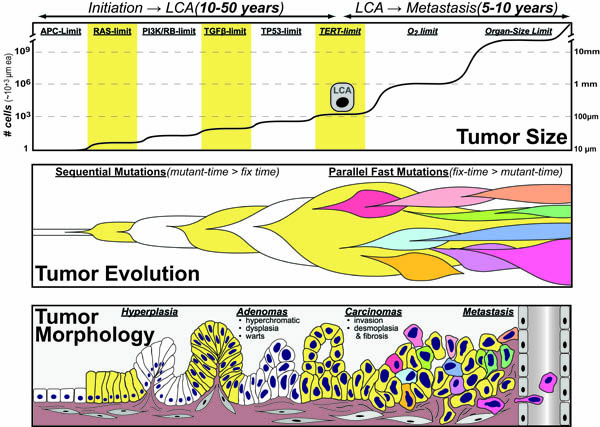Tumors develop in two distinct stages: (1) Initiation to Last-Common-Ancestor(LCA) where 6-8 “driver-mutations” occur sequentially over 10-50 years and (2) LCA to Metastasis where mutations occur more rapidly in parallel. In the first phase, mutations occur slowly and pierce 6-8 barriers to unrestrained growth by “hot-wiring” pro-growth pathways and then “shorting-out” pro-death pathways . In the second phase, genomic instability creates a large-heterogeneous-population that is well-equipped to compete against bigger-picture-limitations such as oxygen-availability, tissue-size, attacking immune cells and chemotherapies.
In the graphic above, we try to combine 3 common visualizations for tumor development into one unified-conceptual image. This graphic can be thought of as conceptual-model of Chapter 11 of Weinberg’s Biology of Cancer.1 The top-graphic on the step-wise nature of early-tumor growth was inspired by a article in Nature Reviews Cancer and some early models of tumor growth kinetics.2-5 The middle and bottom graphics attempt to capture parallel “internal” changes in tumor heterogeneity (middle) and morphology (bottom) by color-coding different clones within the famous “Vogelgram.” The middle-graphic was inspired by the mathematical modeling of Martin Nowak along with phylogenetic work by several groups on several cancers.6-9
REFERENCES:
- Weinberg, R.A. The Biology of Cancer (2nd ed.), 2014, Garland Science.
- Aktipis, C.A. et al. Life history trade-offs in cancer evolution. Nat. Rev. Cancer, 2013, 13, 883.
- Laird, A.K. Dynamics of Tumor Growth Br. J. Cancer, 1964, 18, 490.
- Kendel, W.S. Gompertzian growth as a consequence of tumor heterogeneity. 1985, 73, 103.
- Byrne, H.M. Dissecting cancer through mathematics: from the cell to the animal model. Nat. Rev. Cancer, 2010, 10, 221.
- Michor, F.; Iwasa, Y.; Nowak, M.A. Dynamics of cancer progression. Nat. Rev. Cancer, 2004, 4, 197.
- Yates, Y.R.; Campbell, P.J. Evolution of the cancer genome. Nat. Rev. Genetics, 2012, 13, 795.
- Luebeck, E.G. Genome evolution of metastasis. Nature, 2010, 467, 1053.
- Caravagna, G.et al. Algorithmic methods to infer the evolutionary trajectories in cancer progression. PNAS, 2016, 113, E4025

This work by Eugene Douglass is licensed under a Creative Commons Attribution-NonCommercial-ShareAlike 3.0 Unported License.

